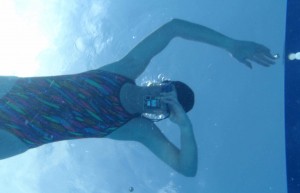When I first started swimming with my Fastlane current generator, I had a lot of trouble with getting sea sick. For the first couple of weeks, 15-20 minutes in the pool was all I could handle. When I had been trying to swim for that amount of time, I would feel my first wave of nausea. I generally didn’t feel an unbearable nausea while still in the pool, but, oddly, it would usually get much worse the second I got out of the water. I would have to be careful to not move my head. It became necessary to time my swimming routine so that there was nothing too important scheduled for a couple of hours after the swim. Sometimes, the only thing to be done was to lie down.
But one does not spend a few thousand dollars on a pool, just to give up when there is trouble. I am happy to say that I can now swim for 40 minutes. Now, I stop swimming because I have reached my training limit. I have only occasionally had the barest twinges of motion sickness lately. It does not happen with every swim and it is not even close to incapacitating. I believe my progress is a combination of management and my body’s system being slowly able to adjust to the motion of the water. Here are some things I learned:
- Make sure the Fastlane is set at the correct level compared to the water.
- Eat a dry, carbohydrate snack just before getting in to swim, and also right afterward. Wheat Thins or a piece of plain bread are what I eat.
- Recognize the first signs of building motion sickness and get out of the pool when you do.
- Avoid moving to the side of the pool during the swimming session, while the current generator is operating. It might seem like a good place to rest, but the change in the water flow direction further “stimulates” the wrong motion sensors.
- Relax in the current so that you are not bobbing up and down, fighting the current when stroking. Set the flow rate such that you can relax your effort and form. The rate can be gradually increased as you get more comfortable swimming against the current.
- Gradually increase the length of swim time/pool time. This goes along with point #2. It didn’t take me too long to notice that I could swim a bit longer, but I didn’t push the limits.
- Try to increase the length of time that is actual swim time. The longer interval means less up and down time. An easy view of an underwater timer can help with this. When I was having more trouble being sick, this made a big difference. Since I’ve had less trouble, it hasn’t been as important.
- Work on your form. A relaxed, but strong, form will make your swimming smoother. One key part of this making sure to roll enough to get your breath.
- Swim about 2-3 times per week. This was a good balance for me. It helped keep me in the groove, enabling me to make progress, but wasn’t as overwhelming as being sea sick every day.
My husband is very interested to see if the progress I’ve made with not having motion sickness in the pool will translate to all the other activities that make me sick. I will be cautious. Probably one of the first things we’ll try is the pedal boat on a windy day. Meanwhile, I am greatly relieved to be able to more fully enjoy my pool.

